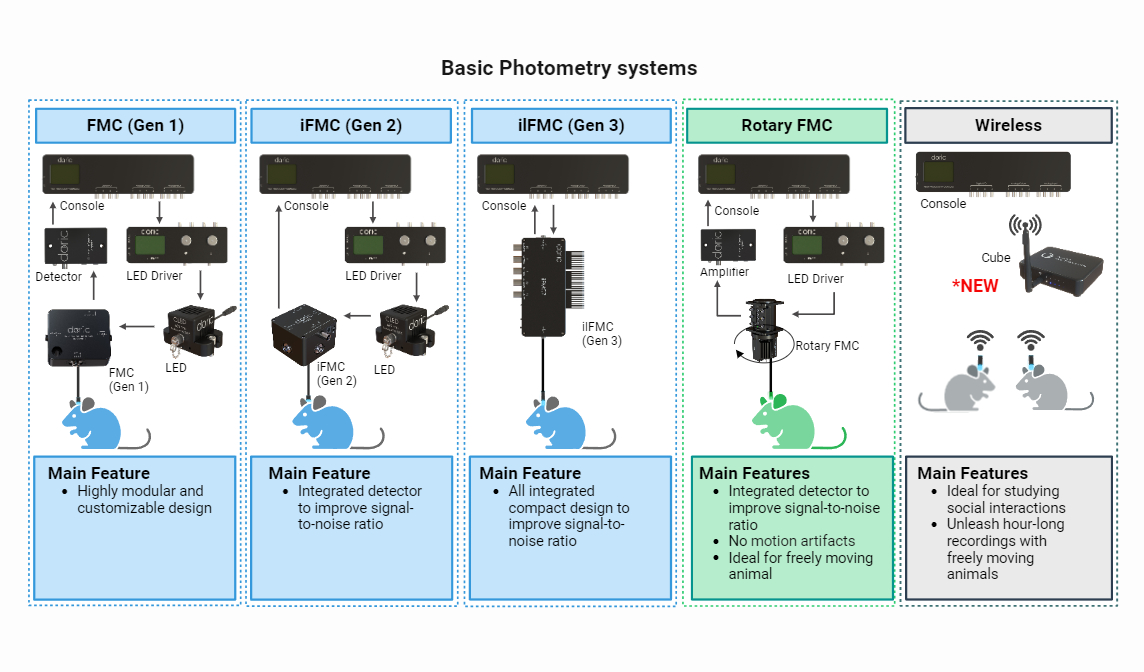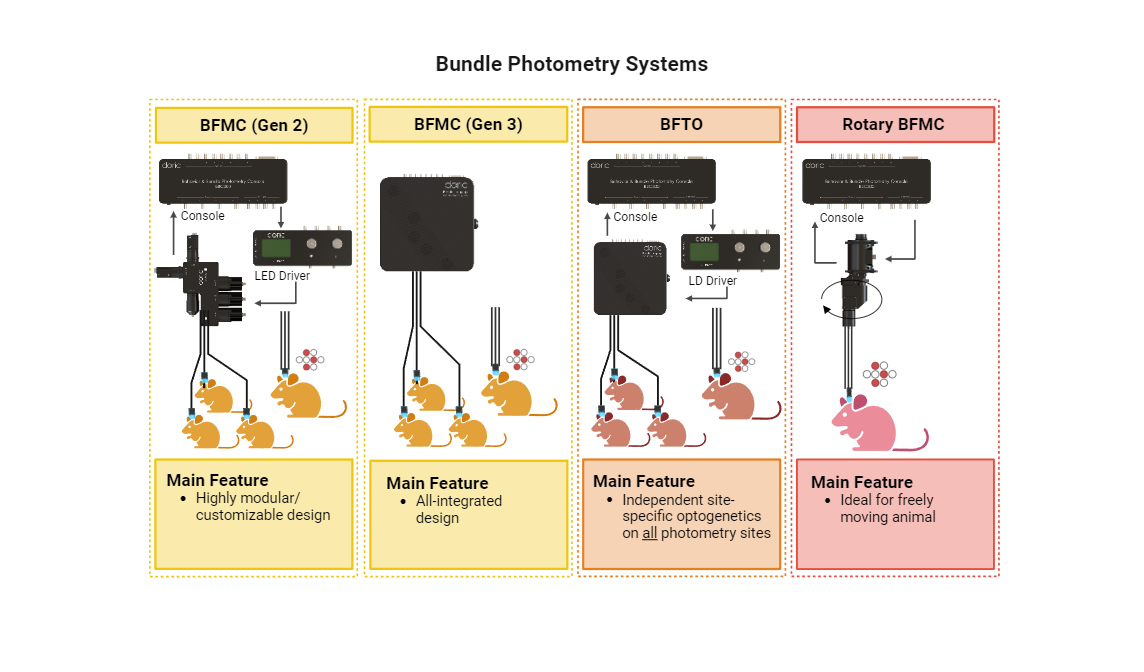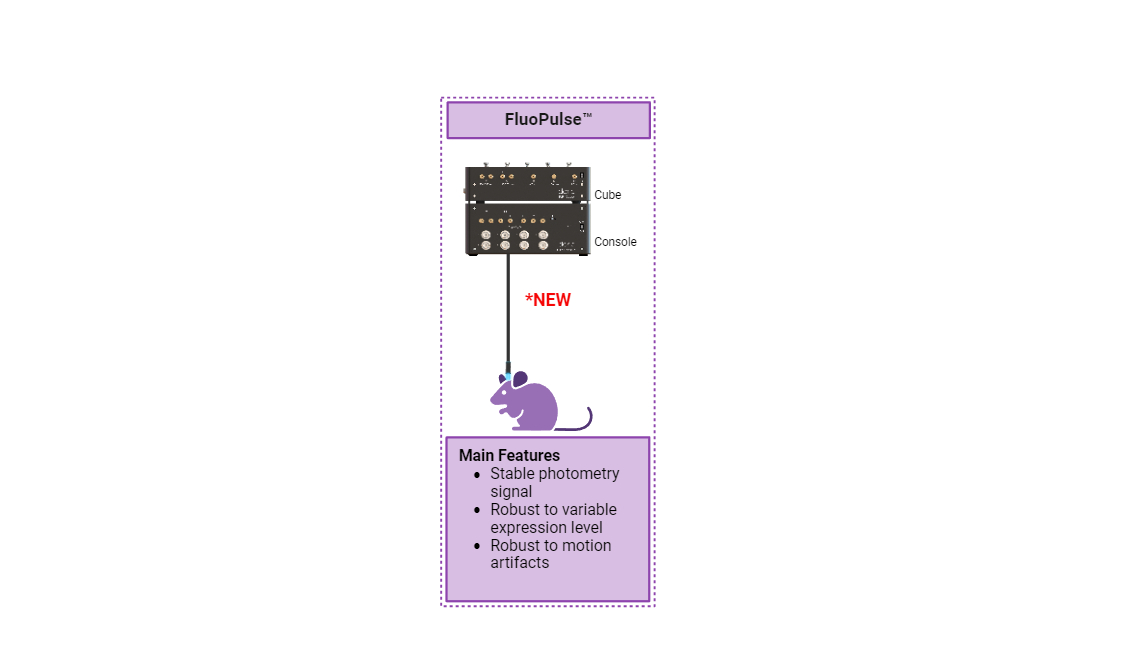Fiber Photometry Solutions
Unlike Doric Miniscopes, which resolve single-cell activity, fiber photometry records population signals (i.e bulk fluorescence from labelled neurons). But unlike microscopy, fiber photometry is minimally invasive, optimized for multi-animal & multi-site experiments, and more cost-effective.
.jpg)
Fiber Photometry Systems Comparison
Doric Lenses Inc. is a recognized leader in advanced fiber photometry solutions for behaving animals, driving innovation in this rapidly evolving field. The image below provides an overview of all photometry systems currently available. Each system was carefully engineered to address the specific experimental needs & challenges.
.jpg)
The photometry systems are divided based on their detector:
- Basic: photodetector with high sensitivity and high temporal resolution.
- Bundle Systems: CMOS camera images multiple fibers simultaneously.
- Lifetime: fast photodetector measures changes in fluorescence lifetime at nanosecond level.
Basic Fiber Photometry Systems
Basic Fiber Photometry Systems are designed to record fluorescence signals sampled with one optical fiber per cube. However, it is possible to combine multiple cubes to record from more than one mouse or brain site. Doric Lenses offers three (3) different system configurations to accommodate experiments with freely moving animals. The Fiber Photometry Mini-Cube (FMCs), the Rotary Fiber Photometry Mini-Cube (RFMC), and the Wireless Photometry system.

The FMCs are subcategorized into: FMC, iFMC, and ilFMC, depending on their level of integration. The FMC has an all-optical fluorescence cube with external light sources and detector for recording photometry signals. This modular design makes it highly customizable for different applications. The iFMC though, only requires a separate light source as the photodetector is integrated within the cube purposefully to increase the signal-to-noise ratio. The ilFMC contains all detector and light sources within the cube. Therefore, not only the signal-to-noise ratio improves, but also the system is simpler and user-friendly. Notably all FMC systems can be used with our pigtailed rotary joints (FRJ_1x1_PT, FRJ_2x2_PT & AFRJ_2x2_PT) for either 1-site or 2-site long-term, freely-moving experiments.
In Rotary Fiber Photometry Mini-Cube (RFMC) the fluorescence cube, the excitation light and the detectors are embedded on the rotary joints itself. This unique setup minimizes movement artifacts in the signal, resulting in more reliable data collection. Meanwhile, the detector is also embedded inside the cube to increase the signal-to-noise ratio. Therefore, RFMC system boasts the highest quality signal recording among all options, albeit at a slightly higher cost. The rotary joint also contains a hollow channel for passing extra cables or tubes for optogenetic stimulation, fluid delivery, or electrophysiology recording, at a distinct site from the photometry sites.
Lastly, considering that wired setups often lead to tangling issues in freely moving animal, especially during social interaction of several mice in the same cage, at Doric Lenses, we have recently developed a new solution, the Wireless Photometry product. Two excitation light, one detector and all electronics and optics are integrated onto lightweight battery operated headstage with wireless communication. This system is ideal to study neural population underpinning social behaviors but is limited to 1-color green emission detection (500-550 nm) with 2 excitations; isosbestic (405, 415 nm) and functional (470 nm).
All basic systems use lock-in or interleaved signal demodulation algorithms. The photodetectors of basic systems also capture data at a high sampling rate, which is then down sampled to 60 Hz. Additionally, the FMC systems are compatible with red-shifted optogenetics over the photometry site, while RFMC can only support optogenetic stimulations in a different site.
Bundle Fiber Photometry System
While the basic fiber photometry systems are typically designed to record from a single mice brain, still multiple cubes can be combined to record from several mice or several brain regions. However, this approach rapidly increases the complexity of the setup and poses challenges in synchronizing the recordings, especially for 3+ sites/animals.
To address this issue, Doric Lenses has designed series of Bundle Photometry System, specified for simultaneous recording from multiple animals or various brain regions of a single mice (1-19 target regions), all at a reasonable price.
The Bundle Photometry System includes 3 subcategories including the Bundle Fiber Photometry System (BFMC), Bundle Fiber Photometry with Targeted Optogenetic (BFTO) and the Rotary Bundle Fiber Photometry (RBFMC) (see image below).
The BFMC has two version depending on the integration level. The newer version of BFMC system has a fully integrated design (CMOS camera, LEDs, LED Driver & console), greatly simplifying the set up compared to the standard BFMC system. However, both BFMC systems are not compatible with optogenetics.
The BFTO system is specifically designed to combine multi-fiber photometry and targeted optogenetics. Independent multi-site optogenetic control is ideal for close-loop optogenetics (both multi-animal and/or multi-site) experiments.
This system provides the greatest flexibility for common neuroscience experiments.
Unlike the BFMC and BFTO systems, the RBFMC has a rotating cube that helps eliminate movement artifacts, allowing for high-quality signals. However, this benefit comes at the cost of being limited to recording different brain regions from a single mouse. Additionally, the RBFMC includes optogenetic capabilities that can illuminate all sites simultaneously.
All bundle systems use CMOS camera detector that images entire fiber bundle simultaneously. The power LEDs excite the entire fiber bundle, and the photometry signal is then sampled at 10-20 Hz depending on the configuration.

FluoPulse™
FluoPulse™ is a novel photometry system from Doric Lenses which works by measuring fluorophores lifetime rather than fluorescence intensity level. It is designed to measure fluorescence lifetimes ranging between 1-10 ns and can resolve differences in lifetime of 10-20 ps. The measured photometry lifetimes are then averaged at 10 Hz to obtain photometry signal.
Thus, it is compatible with most biosensors designed for Fluorescence Lifetime Microscopy (FLIM) and Förster’s Resonance Energy Transfer (FRET), including FLIM-AKAR, GRAB-Ach3.0, etc.
By sampling fluorophores lifetime rather than intensity, FluoPulse™ offers several advantages, including highly stable fluorescence imaging which is robust to sensor expression level, autofluorescence, photobleaching, excitation power, and movement artifacts and ambient light. This makes it ideal for long-term studies lasting weeks or months, as well as for comparing results across different animals, time points, and brain regions.

External References (Basic fiber photometry system)
|
1. Protocol for in vivo dual-color fiber photometry in the mouse thalamus. Star Protocol.10.1016 (2024). Link |
| 2. Sharma S et al. Inhibitory medial zona incerta pathway drives exploratory behavior by inhibiting glutamatergic cuneiform neurons. Nat. Commun. 15(1):1160 (2024). Link |
| 3. Lee Y.H et al. Lateral hypothalamic leptin receptor neurons drive hunger-gated food-seeking and consummatory behaviours in male mice. Nat. Commun. 14(1):1486 (2023). Link |
| 4. Khalil V et al. Subcortico-amygdala pathway processes innate and learned threats. elife. 12:e85459 (2023). Link |
| 5. Conde-Berriozabal S et al. M2 Cortex Circuitry and Sensory-Induced Behavioral Alterations in Huntington's Disease: Role of Superior Colliculus. J. Neurosci. 43(18):3379-3390 (2023). Link |
| 6. Linders L.E et al. Stress-driven potentiation of lateral hypothalamic synapses onto ventral tegmental area dopamine neurons causes increased consumption of palatable food. Nat. Commun. 13(1):6898 (2022). Link |
| 7. Chen D et al. Deconstruction of a hypothalamic astrocyte-white adipocyte sympathetic axis that regulates lipolysis in mice. Nat. Commun. 13(1):7536 (2022). Link |
| 8. Zessen R.V et al. Cue and Reward Evoked Dopamine Activity Is Necessary for Maintaining Learned Pavlovian Associations. J. Neurosci. 41(23):5004-5014 (2021). Link |
| 9. Tecuapetla F et al. Balanced activity in basal ganglia projection pathways is critical for contraversive movements. Nat. Commun. 5, 4315 (2014). Link |
| 10. Lerner TN et al. Intact-Brain Analyses Reveal Distinct Information Carried by SNc Dopamine Subcircuits. Cell 30, 635-47 (2015). Link |
|
11. Kim CK, et al. Simultaneous fast measurement of circuit dynamics at multiple sites across the mammalian brain. Nat Methods 13, 325-8 (2016). Link |
External References (Bundle fiber photometry system)
| 1. Sayar-Atasoy N et al. AgRP neurons encode circadian feeding time. Nat. Commun. 27(1):102-115 (2024). Link |
| 2. Zhuo Y et al. Improved green and red GRAB sensors for monitoring dopaminergic activity in vivo. 21(4):680-691 (2024). Link |
| 3. Qian T et al. A genetically encoded sensor measures temporal oxytocin release from different neuronal compartments. Nat Biotechnol. 41(7):944-957 (2023). Link |
| 4. Guillaumin M.C.C et al. Disentangling the role of NAc D1 and D2 cells in hedonic eating. Mol Psychiatry. 28(8):3531-3547 (2023). Link |
| 5. Toader A.C et al. Anteromedial thalamus gates the selection and stabilization of long-term memories. Cell. 186(7):1369-1381.e17 (2023). Link |
| 6. Sayar-Atasoy N et al. Adrenergic modulation of melanocortin pathway by hunger signals. Nat. Commun. 14(1):6602 (2023). Link |
| 7. Aklan I et al. Dorsal raphe serotonergic neurons suppress feeding through redundant forebrain circuits. 69:101676 (2023). Link |
